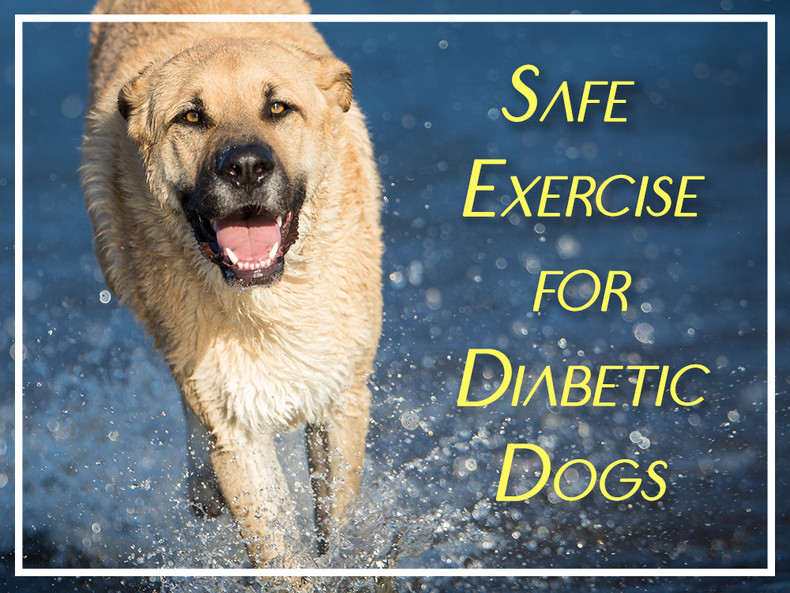How Do I Safely Exercise My Diabetic Dog?
A big thank you to Paul for suggesting this topic for today! As we have chatted about before, exercise is one of the “staples” of Canine Diabetes management. Now given that Canine Diabetes is typically a “later in life” diagnosis, the temptation is there to just stop exercise all together. I will suggest to you that this is not the time to stop exercising your pup. You just need to do it safely.
If you have always taken daily walks, please keep doing it, not just because your pup now has diabetes, but because it is a wonderful way to keep your pup engaged in life. I once heard it said that for a dog, taking a walk is like reading the newspaper for us humans. They sniff every bush and blade of grass and can now tell you who’s been through the neighborhood, who had steak for dinner last night and who’s not feeling very well today.
If you’ve never taken your pup for walks, and you decide to start now, please start gradually. Here is another situation where testing is very, very important! Once again, your meter is your best friend. Knowing how exercise affects BG (Blood Glucose) numbers is very important when it comes to the safety of your pup. For some, it lowers their numbers and for some it can increase numbers. Knowing where you and your pup fall in that spectrum is valuable information. For me, exercise brought numbers down and the only time that I ever found myself in a hypo situation (BG of 32!) was just after a wonderful walk on a lovely spring day.
How do we exercise our pups safely? We make sure that we don’t exercise for the first hour to hour and a half after an insulin injection as this can change the absorption rate of the insulin. Once we are out of that time frame, we test BG (Blood Glucose) to see where we are. If all is well and we are in a safe range (200 or higher, or wherever you feel comfortable knowing that exercise could drop your numbers) we will get ready to have some exercise. For me this meant getting the boys in their harnesses and me getting my “walk kit”. I had a medium sized fanny pack that had everything that I might need in it.
My Walk Kit:
- A meter and strips
- Dog Biscuits
- S O S packets
- My phone
- And of course poop bags
You have tested before leaving, now it’s time to test midway through your walk if it is any more than 15 to 20 minutes. You are establishing a baseline here to see how things are going. If your walk is a short one, 15 minutes or so, then you can test when you get home, but ALWAYS have your walk kit with you in the event that something unexpected comes up (you see another dog, a squirrel, the post man or it’s a little hotter and more humid that day). Being 7-10 minutes from home and something going wrong is just not worth the risk, so have your walk kit with you always!
If you have just returned from your walk, now is the time to test to see where BG (Blood Glucose) is. Record your findings in your journal including what the weather was like, duration of the walk and if there was any excitement out of the ordinary. If BG (Blood Glucose) is a bit low (under 150), give a treat to bring up that number, do not over treat as we just want to bring the number up a bit. I have mentioned in the blog about Hypoglycemic Events, knowing how many points you get from each type of treat so that you can be prepared is always a good idea.
Now you know if a walk brings your pup’s numbers down, increases them or has no affect at all. And here’s a little twist, if your pup is running higher than usual, it’s possible that the walk can increase the numbers a bit even though they typically lower them. The only way to know is to test, exercise and re-test.
Worth noting here that if your numbers are a bit lower than usual on a particular day and you know that a walk or car ride brings your BG (Blood Glucose) down, that doesn’t mean that you have to forego your walk that day, simply give a small treat to your pup before you leave on your walk as a precaution. If your walk is long, test part way through and have your supplies with you so you can give a treat at the midpoint of your walk.
Exercise is a wonderful thing for your pup especially if they are getting up in years. As my Grandmother with arthritis used to say… “Motion is lotion”. So enjoy your daily walks with your pup now that you know how to do it safely!
Notice that for most of the products or groups that I mention, the text is linked to a website that you can purchase that item or a link to join the group mentioned. Just click on the colored text (red or blue, depending what device you are on) and it should take you right to the item or group. If you have any thoughts or ideas for topics that you’d like to see covered here, please feel free to comment below or send us an email at ecommerce@pharmasupply.com. As always, please “like” this blog post or any of the others that have helped you or just refreshed your memory. Look for new posts every week!
Until next time…

